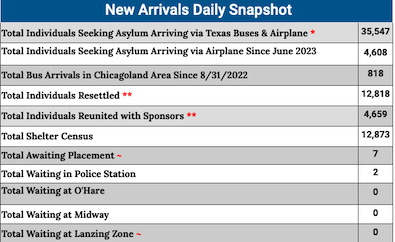* From S&P Global Ratings…
Migrants And Asylum Seekers Pose Budgetary Challenges In New York City, Chicago, And Denver
State and local governments are shouldering the rapidly growing costs of assisting migrants and asylum seekers as their numbers increase in the U.S. In December 2023, the immigration court backlog reached 3 million pending cases, an increase of 1 million from 2022, with almost 2 million new proceedings filed in 2023 (see chart 1). If this issue remains significant enough for long enough, the increase in costs and social service requirements could affect states’ and local governments’ credit quality. Migrants and asylum seekers come to the U.S. through a variety of entry points, but many come through the U.S. southern border in Texas. To address this influx, Texas began transporting new arrivals out of the state in 2022. Since then, of the 100,000 migrants and asylum seekers Texas has transported, 83,600 were sent to three cities: New York (NYC), Chicago, and Denver. […]
Although it seems likely that [Chicago’s] 2024’s costs will exceed budgeted amounts (particularly since, on Jan. 29, 2024, the mayor extended the maximum stay time in shelters by 30-60 days for most migrants), the city has not shared contingency plans for managing unbudgeted expenditures. Given that Chicago’s $16 billion budget was balanced using $50 million in corporate fund reserves and $139 million in other one-time money, without new revenues, the overages from the $150 million might have to come, at least in part, from reserves that stood at $1.9 billion (39% of expenditures) at year-end 2022, up from $1.4 billion (27.5% of expenditures) at year-end 2021. If support from the state and federal governments does not materialize as expected, the impact on Chicago’s bottom line could be sizable. How the city manages these pressures, particularly when faced with high costs for its underfunded pension programs, could have a longer-term effect on its credit quality. […]
So far, the federal government’s support has been more limited. In December 2022, the Bipartisan Year-End Omnibus spending bill authorized an $800 million grant program through the Federal Emergency Management Agency (FEMA). Of those funds, NYC received more than $130 million in calendar 2023. Chicago received approximately $40 million in asylum seeker grants from FEMA in 2023, but grants often fall short of needs: for example, Chicago asked FEMA for between $39 million and $67 million, but received only $4.3 million. Given current political dynamics in Washington D.C. and the upcoming presidential election, we do not consider additional federal support likely. Therefore, cities on the front line of migrant and asylum seeker inflows will have to face the uncertainty of rising costs without a guarantee of revenues to offset the expenditures.
* The Bond Buyer talked with Justin Marlowe, research professor at the University of Chicago’s Harris School of Public Policy and director of the school’s Center for Municipal Finance about this topic…
Marlowe said he didn’t see the problem approaching the scale where it would affect bond ratings, but he acknowledged that some of the fiscal pain initially felt by Chicago is now spreading elsewhere.
* However…
U.S. Immigration and Customs Enforcement has drafted plans to release thousands of immigrants and slash its capacity to hold detainees after the failure of a Senate border bill that would have erased a $700 million budget shortfall, according to four officials at ICE and the Department of Homeland Security. […]
The supplemental bill had $7.6 billion for ICE overall, including $2.6 billion for deportation flights and $3.2 billion for detention capacity, money that would have boosted capacity by thousands of beds per day. The agency has contracts and agreements with scores of local and county jails across the United States where it can place detainees for weeks, months and sometimes longer as they await a court ruling or face deportation. About half of ICE’s $8.5 billion annual budget is used for detention and deportation operations.
* In the short term, at least, shelter population continues to fall. Numbers as of 10:30 this morning…

Yesterday’s numbers are here.
* Tribune…
Johnson’s deputy chief of staff Cristina Pacione-Zayas noted to reporters the progress coincided with accelerated efforts to resettle migrants in permanent housing or in other cities. But she acknowledged hard choices lie ahead for the city as the $150 million Johnson budgeted for the migrant response this year is slated to be spent by April.
“Every day we’re in meetings, on calls with the state, with the county, to figure out what the long-term plan is to get through the calendar year together,” Pacione-Zayas said.
She did not say whether closing shelters or making budget cuts mid-year was on the table.
* More from Isabel…
* WaPo | Here’s which states could benefit most from migrant labor: Economists, however, would point out that “burden” is the wrong word to describe immigration’s impact. The plentiful supply of immigrants is one of the main reasons the U.S. economy has outperformed that of its peers in the affluent world since the eve of the pandemic, accounting for the entire growth of the labor force. Without immigrants, growth would have been slower and inflation higher.
* NBC Chicago | Thousands of migrants in Chicago on edge as shelter evictions loom: Thousands of migrants across Chicago are on edge as the shelter eviction deadline nears. Many of the migrants who are seeking alternative housing are struggling to receive work permits, which are necessary to secure housing.
* WIFR | Capron village board organizes plans in case of migrant drop-off: The village of Capron held a board meeting to come up with a blueprint for action, in the event a busload of migrants stops in their town. Village President Steven Banks discusses two ordinances that would counter any intercity buses coming to the town. “People can get permission to drop people off and then the village will have the right to approve or deny that application and we also don’t have anything currently in our code that gives the village president emergency authority,” said Banks. “We tend to be immune from the big city problems… until they landed 300 of them in Rockford airport.”
* CBS Chicago | Suburban Chicago woman arrested for human trafficking of Mexican migrants: Olea promised housing, safety, and jobs, but after arriving, investigators said Olea took possession of their identification, money, and other items. Olea forced the two adults and the 15-year-old into jobs to pay off their “debt” for safe entry into the United States.















- New Day - Wednesday, Feb 14, 24 @ 1:23 pm:
“ U.S. Immigration and Customs Enforcement has drafted plans to release thousands of immigrants and slash its capacity to hold detainees after the failure of a Senate border bill that would have erased a $700 million budget shortfall, according to four officials at ICE and the Department of Homeland Security. […]
The supplemental bill had $7.6 billion for ICE overall, including $2.6 billion for deportation flights and $3.2 billion for detention capacity, money that would have boosted capacity by thousands of beds per day. The agency has contracts and agreements with scores of local and county jails across the United States where it can place detainees for weeks, months and sometimes longer as they await a court ruling or face deportation. About half of ICE’s $8.5 billion annual budget is used for detention and deportation operations.”
Thanks, Donald Trump and Speaker Johnson for your help in making the immediate crisis much worse.
- Frida’s boss - Wednesday, Feb 14, 24 @ 1:33 pm:
Well the aldermen should threaten the Feds and Gov some more over a Ceasefire that should help